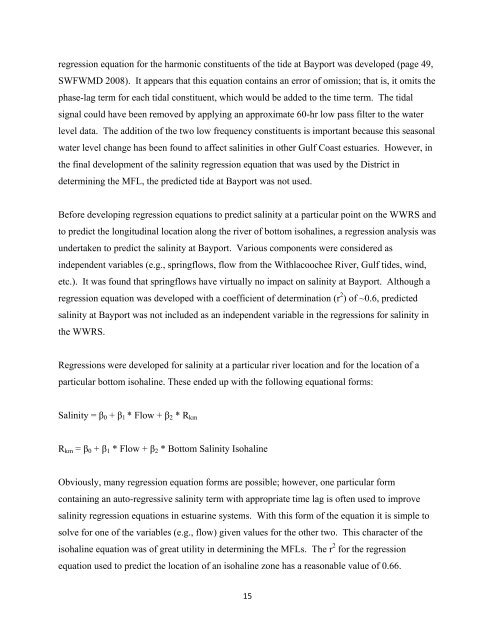Weeki Wachee River System Recommended Minimum Flows and ...
Weeki Wachee River System Recommended Minimum Flows and ...
Weeki Wachee River System Recommended Minimum Flows and ...
You also want an ePaper? Increase the reach of your titles
YUMPU automatically turns print PDFs into web optimized ePapers that Google loves.
egression equation for the harmonic constituents of the tide at Bayport was developed (page 49,<br />
SWFWMD 2008). It appears that this equation contains an error of omission; that is, it omits the<br />
phase-lag term for each tidal constituent, which would be added to the time term. The tidal<br />
signal could have been removed by applying an approximate 60-hr low pass filter to the water<br />
level data. The addition of the two low frequency constituents is important because this seasonal<br />
water level change has been found to affect salinities in other Gulf Coast estuaries. However, in<br />
the final development of the salinity regression equation that was used by the District in<br />
determining the MFL, the predicted tide at Bayport was not used.<br />
Before developing regression equations to predict salinity at a particular point on the WWRS <strong>and</strong><br />
to predict the longitudinal location along the river of bottom isohalines, a regression analysis was<br />
undertaken to predict the salinity at Bayport. Various components were considered as<br />
independent variables (e.g., springflows, flow from the Withlacoochee <strong>River</strong>, Gulf tides, wind,<br />
etc.). It was found that springflows have virtually no impact on salinity at Bayport. Although a<br />
regression equation was developed with a coefficient of determination (r 2 ) of ~0.6, predicted<br />
salinity at Bayport was not included as an independent variable in the regressions for salinity in<br />
the WWRS.<br />
Regressions were developed for salinity at a particular river location <strong>and</strong> for the location of a<br />
particular bottom isohaline. These ended up with the following equational forms:<br />
Salinity = β 0 + β 1 * Flow + β 2 * R km<br />
R km = β 0 + β 1 * Flow + β 2 * Bottom Salinity Isohaline<br />
Obviously, many regression equation forms are possible; however, one particular form<br />
containing an auto-regressive salinity term with appropriate time lag is often used to improve<br />
salinity regression equations in estuarine systems. With this form of the equation it is simple to<br />
solve for one of the variables (e.g., flow) given values for the other two. This character of the<br />
isohaline equation was of great utility in determining the MFLs. The r 2 for the regression<br />
equation used to predict the location of an isohaline zone has a reasonable value of 0.66.<br />
15
















